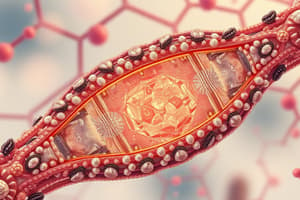Podcast
Questions and Answers
Question 1: What is the primary purpose of inspecting the undercarriage of a vehicle after an accident?
Question 1: What is the primary purpose of inspecting the undercarriage of a vehicle after an accident?
- To check for damage to critical components (correct)
- To identify cosmetic damage
- To determine the car's color
- To assess the thickness of brake pads
Question 2: Which component of the undercarriage can lead to fuel leaks, reduced handling, or scraping noises while driving if damaged?
Question 2: Which component of the undercarriage can lead to fuel leaks, reduced handling, or scraping noises while driving if damaged?
- Brake lines
- Frame and chassis
- Exhaust system (correct)
- Suspension
Question 3: What does 'frame twisting' in the undercarriage refer to?
Question 3: What does 'frame twisting' in the undercarriage refer to?
- Cosmetic damage to the car's frame
- Damage to alloy or steel wheels
- Severe bending or twisting of the car's frame (correct)
- Misalignment of the car's wheels
Question 4: What can be determined by inspecting the undercarriage of a vehicle after an accident?
Question 4: What can be determined by inspecting the undercarriage of a vehicle after an accident?
Question 5: What is the purpose of inspecting the thickness of brake pads in the undercarriage?
Question 5: What is the purpose of inspecting the thickness of brake pads in the undercarriage?
Which one of these is NOT a potential consequence of damage to the exhaust system in the undercarriage?
Which one of these is NOT a potential consequence of damage to the exhaust system in the undercarriage?
Which one of these is NOT a potential cause of frame twisting in the undercarriage?
Which one of these is NOT a potential cause of frame twisting in the undercarriage?
What type of damage in the undercarriage can potentially lead to alignment issues?
What type of damage in the undercarriage can potentially lead to alignment issues?
What is NOT a primary purpose of inspecting the undercarriage of a vehicle after an accident?
What is NOT a primary purpose of inspecting the undercarriage of a vehicle after an accident?
Which one of these is NOT a potential component of the undercarriage that can lead to fuel leaks, reduced handling, or scraping noises while driving if damaged?
Which one of these is NOT a potential component of the undercarriage that can lead to fuel leaks, reduced handling, or scraping noises while driving if damaged?




